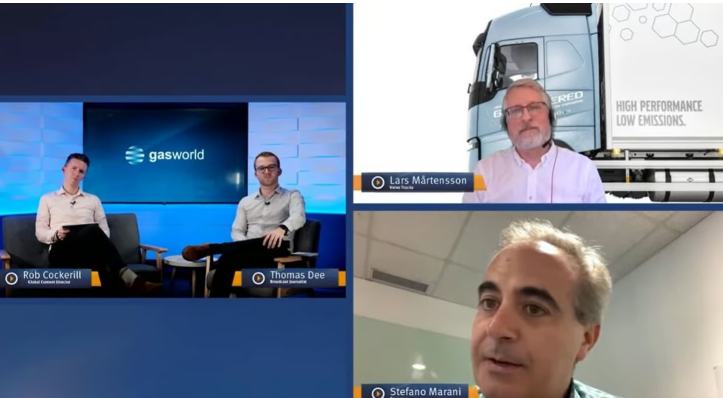
Liquefied natural gas (LNG) has much bigger potential than Compressed Natural Gas (CNG) for regional and long-haul trucking, according to Lars Mårtensson, Director of Environment & Innovation at Volvo Trucks.
Speaking at the gasworld LNG: What Future? webinar, he said Volvo Trucks, whose sales portfolio spans 140 countries, has set a target of having 30% of its Sweden sales gas-powered by 2025.
“Demand is growing and it’s quite clear to us that gas-powered trucks have major potential to grow going forward,” he said. “With LNG, we have the potential to reduce the climate impact compared with diesel, and this is a strong requirement from many of the major transport buyers in the world, and this helps grow interest in LNG. We see much bigger LNG potential with freight transport than with CNG.”
LNG generates 30% less CO2 than diesel fuel and 45% less than coal.
Volvo Trucks uses gas engines based on diesel combustion technology, meaning it replicates the performance of diesel models, added Mårtensson. “You will not lose the driveability or ability to transport heavy loads, and we get the energy efficiency, the longer range and the opportunity to reduce the fuel costs quite substantially.
“There is not one solution that fits all. We don’t see BEVs for long-route freight transport, but strongly believe gas-powered trucks will be a key part of the solution. We work in quite a conservative industry and it takes a while to build infrastructure. We need to cooperate, and solve the ‘chicken and egg’ problem of getting the energy and infrastructure in place. We see potential for bio-LNG and hope that will grow significantly in the coming years as well.”
Stefano Marani, CEO at Renergen, started the webinar outlining challenges operating in the South African market and potential of its LNG business.
Renergen will sell its LNG product to domestic consumers, targeting primarily the South African transport industry, in which it has established relationships with customers.
“Renergen is the only onshore petroleum production right in the country – and given we were awarded that in 2012, and today we’re still the only petroleum production right holder in the country, is not conducive to assisting the country with its energy needs,” he said.
On the bright side, Renergen – which recently announced production of its first liquid helium at its Virginia Gas Project – has built the first commercial LNG plant in South Africa and it’s going well, he said.
“It’s another arrow in the quiver, in South Africa’s steps to a just transition,” he said. “Part of our business is that we’re allocating up to 40% of total LNG production to substituting diesel in trucks, and our business plan is to roll out a series of LNG filling stations on the motorways between the major cities. I suspect later this year you’ll see the first trucks running on LNG.
AG Image for 355436015Imp for 355436015
“It’s important that the infrastructure can offer 100% LNG – there’s a lot of planning into the future. If everything goes to plan, phase 2 will be operational by 2026. South Africa is well endowed with gas, what’s necessary now is that we get the legislation right, so we can start drilling and exploring, and bringing these reserves on line.”
He remains hopeful that heavy logistics market can serve as an anchor for future LNG projects. “Let’s bring it down to a granular level, and then we’ll have a significant impact. Right now we’re aiming for zero emissions from EVs, but that’s like trying to run when you can’t walk. Copper is going to become very scarce, so unless we find alternatives, that dream is going to die quickly.”
He remains sceptical on some of the take-up of other technologies. “I see a place for biofuels, but I’m not sure about running trucks on hydrogen in South Africa. Right now we are having diesel being drained – so imagine the situation with hydrogen and platinum. Hydrogen has its place, but keeping hydrogen in liquid form is exceedingly difficult.”
Marani urged lenders and policymakers take a little bit more risk. “Force trucks to run on LNG, and then you’ve got thousands of vehicles that need to run on it, and financing becomes easier and we can build more LNG projects. Within a very few short years, we’ve solved the energy crisis.”
Mårtensson said, “If we’re going to be successful with gas-powered trucks, we need to work in partnership to make it happen, on a country and regional basis all over the world.”
According to the Shell LNG Outlook report, if 10% of heavy goods vehicles and 10% of ships switched to run on gas, it would cut 75Mtpa of CO2 emissions. The global trade in LNG increased to 380m tonnes during 2021 as many countries rebounded from the economic impact of the COVID-19 pandemic, and demand has since spiked again following Russia’s invasion of Ukraine.
But ultimately the need to reduce emissions across the board will affect all fossil fuels, including gas and LNG, warns McKinsey.
“Much uncertainty remains regarding which geographies and sectors will act first, as well as how quickly demand will decline,” it notes. McKinsey’s 1.5-degree outlook shows demand at 72% below 2016 levels by 2050.